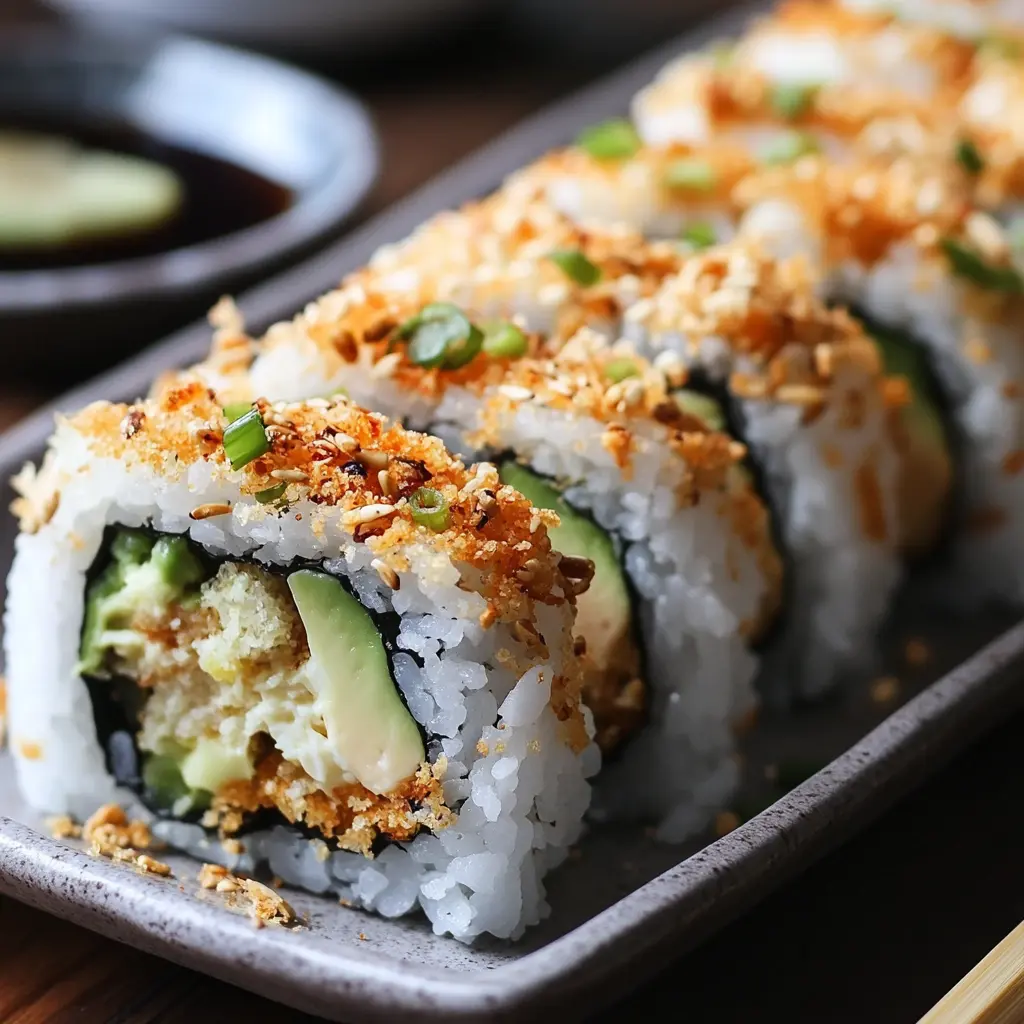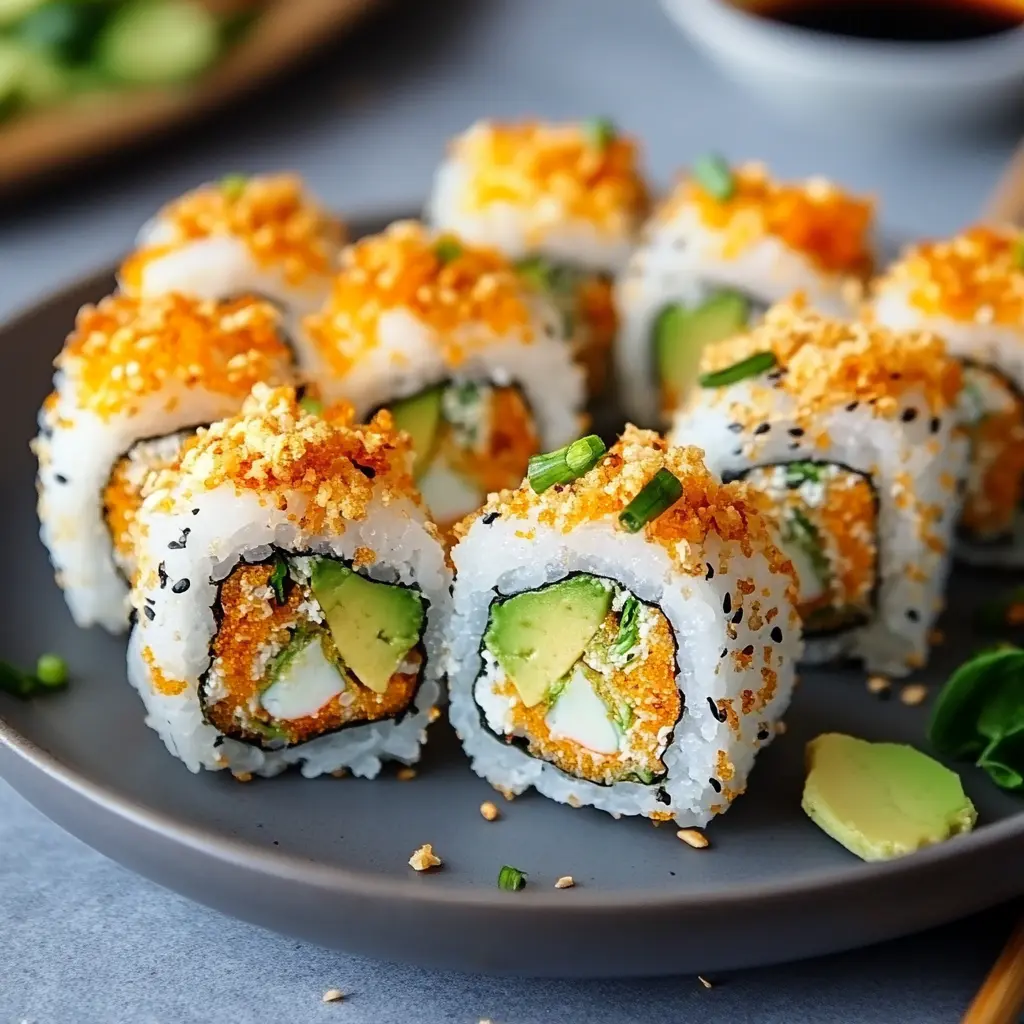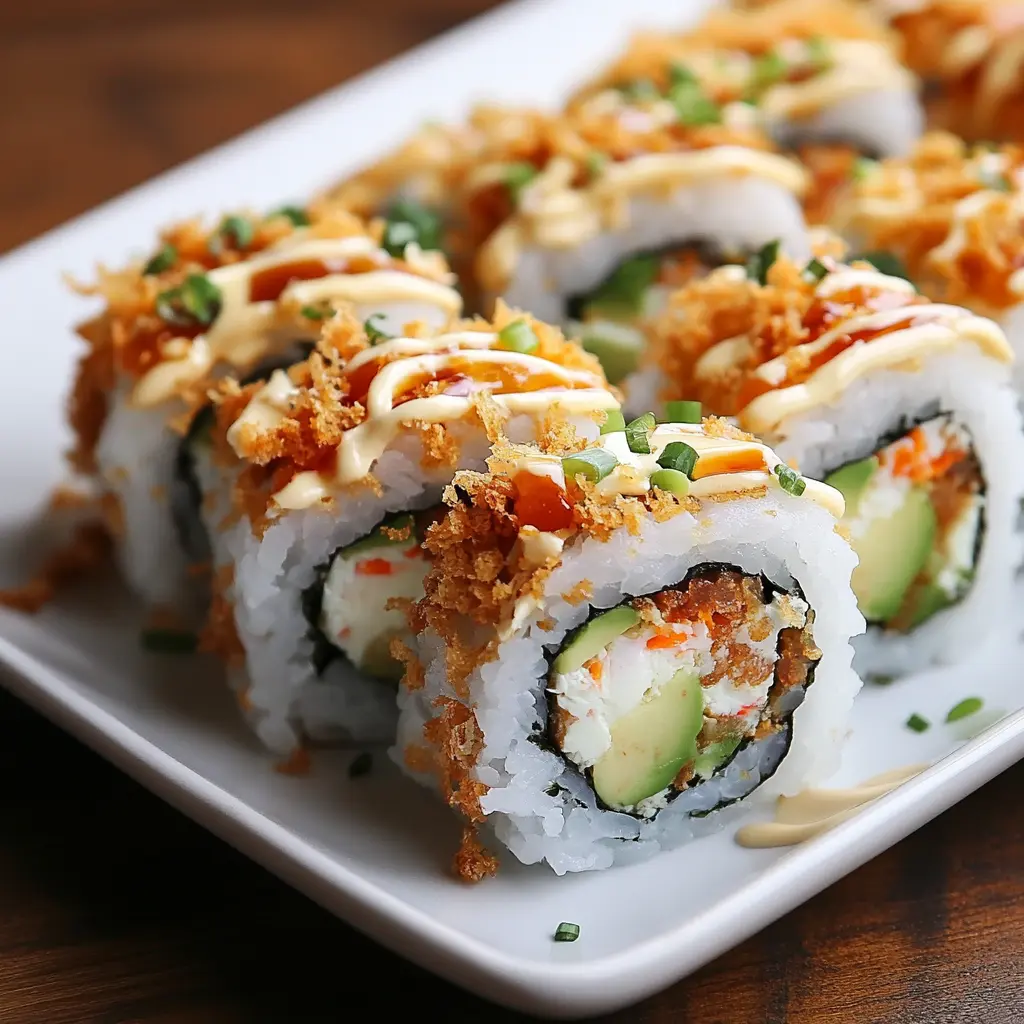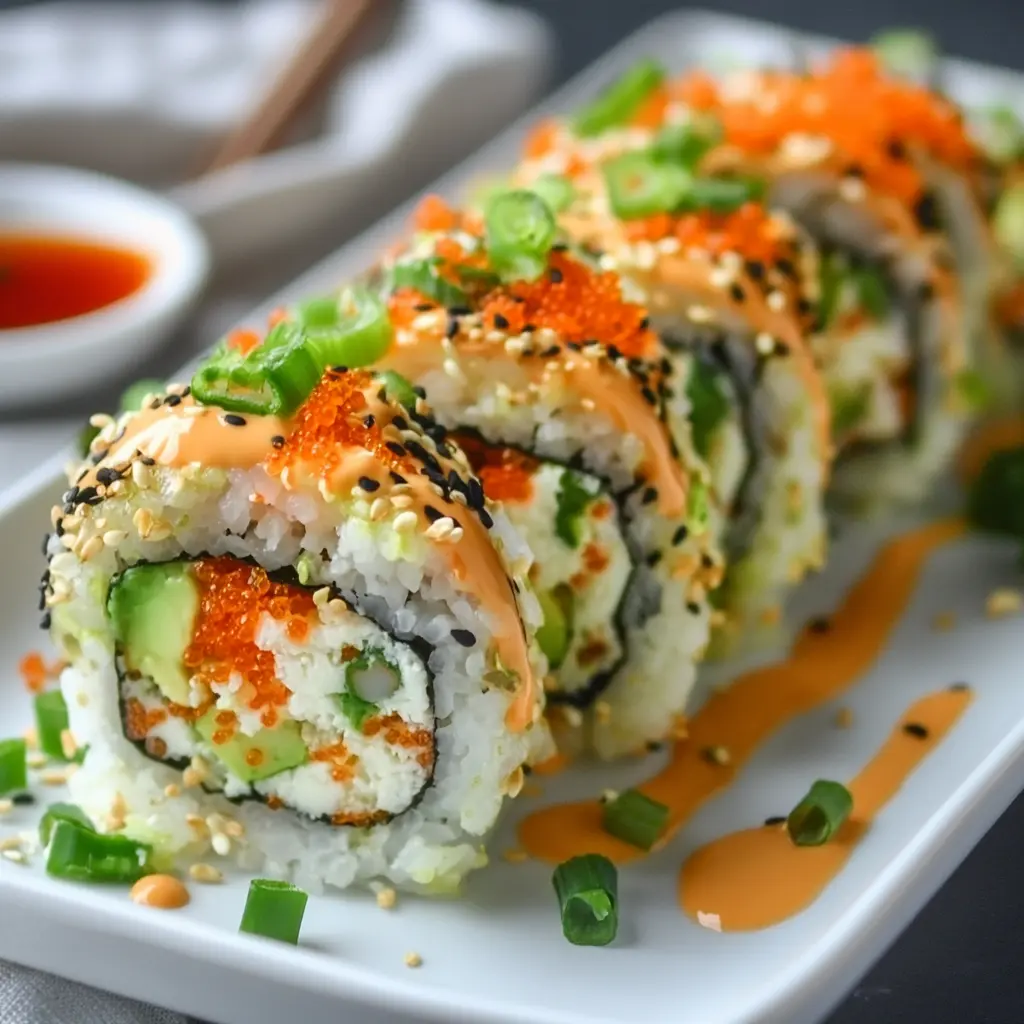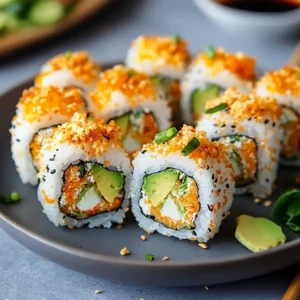California Crunch Roll Sushi is one of the most beloved sushi rolls worldwide, blending creamy textures with a satisfying crunch. Whether you’re a sushi enthusiast or a beginner looking to explore Japanese cuisine, this guide will walk you through everything you need to know about this iconic dish. From its origins and ingredients to how to make it at home and where to find the best versions, we’ve got you covered!
What is a California Crunch Roll Sushi?
Key Ingredients of a California Crunch Roll
At the heart of every California Crunch Roll are its signature ingredients, which combine to create a harmonious blend of flavors and textures. The primary components include:
- Avocado: Known for its creamy texture and mild flavor, avocado adds richness to the roll without overpowering other ingredients.
- Crab Meat (or Imitation Crab): This ingredient provides a sweet, delicate seafood taste. Many recipes use imitation crab, made from fish paste, as an affordable alternative.
- Cream Cheese: A hallmark of the California roll, cream cheese introduces a tangy, smooth element that complements the freshness of the other ingredients.
- Tempura Flakes: These crispy flakes give the roll its distinctive crunch, setting it apart from traditional California rolls.
- Nori (Seaweed): The outer layer of the roll, nori not only holds everything together but also adds a subtle oceanic flavor.
Each ingredient plays a crucial role in balancing the overall taste profile of the roll. Together, they create a symphony of textures—soft, creamy, and crunchy—that makes the California Crunch Roll so irresistible.
How Does It Differ from a Traditional California Roll?
While both rolls share similar ingredients, the key difference lies in the addition of tempura flakes in the California Crunch Roll. Traditional California rolls typically consist of avocado, crab meat, cucumber, and sometimes sesame seeds or tobiko (fish roe). However, the crunch roll takes things up a notch by incorporating crispy tempura flakes either inside the roll or sprinkled on top.
This small variation transforms the eating experience entirely. The crunchiness contrasts beautifully with the softness of the rice and cream cheese, making each bite more dynamic. Additionally, some variations may swap out cucumber for cream cheese to enhance the creamy factor further.
A Brief History of the California Roll
The California Roll is often credited as the gateway sushi for Western audiences unfamiliar with raw fish. Its invention dates back to the 1970s when Chef Ichiro Mashita, working at Tokyo Kaikan restaurant in Los Angeles, sought to adapt traditional sushi to American tastes. By replacing tuna with avocado and adding crab meat, he created a milder, more approachable option.
Over time, chefs began experimenting with new elements, such as cream cheese and tempura flakes, leading to the evolution of the California Crunch Roll. Today, it remains a staple in sushi restaurants across the globe, symbolizing the fusion of Japanese culinary traditions with Western preferences.
Nutritional Value of a California Crunch Roll
For those mindful of their diet, understanding the nutritional content of a California Crunch Roll is essential. While it’s undeniably delicious, moderation is key due to certain high-calorie ingredients like cream cheese and tempura flakes.
- Calories: A single roll (6-8 pieces) can range from 300 to 500 calories, depending on portion size and preparation methods.
- Protein: Crab meat and cream cheese provide a decent amount of protein, though imitation crab contains less than real crab.
- Healthy Fats: Avocado contributes healthy monounsaturated fats, supporting heart health.
- Carbohydrates: Sushi rice is the main source of carbs, offering energy but potentially contributing to higher calorie counts if over-consumed.
To make your roll healthier, consider reducing the amount of cream cheese or opting for brown rice instead of white rice. These small tweaks can help lower the calorie count while retaining the roll’s deliciousness.
If you’re looking for more inspiration or want to explore additional variations of the California Crunch Roll, check out this fantastic guide on California Crunch Sushi Rolls from Fly Peach Pie . They offer creative ideas and step-by-step instructions that can help you take your sushi-making skills to the next level!
How to Make a California Crunch Roll at Home
Essential Tools for Making Sushi Rolls
Creating sushi at home requires minimal equipment, but having the right tools ensures success:
- Bamboo Sushi Mat (Makisu): This flexible mat helps shape and compress the roll evenly. It’s inexpensive and widely available online or in kitchen supply stores.
- Sharp Knife: A sashimi knife or any sharp blade is necessary for slicing the roll cleanly without squishing it.
- Rice Cooker: While optional, a rice cooker simplifies the process of preparing perfectly cooked sushi rice.
- Cutting Board: Use a clean, flat surface to assemble and cut your rolls safely.
Having these tools ready before starting will streamline the process and improve your results.
Step-by-Step Guide to Rolling a Crunch Roll
Making a California Crunch Roll might seem intimidating, but with practice, anyone can master it. Follow these steps:
- Prepare the Rice: Rinse sushi rice thoroughly, then cook according to package instructions. Once cooked, mix in seasoned rice vinegar until glossy.
- Lay Out the Nori: Place a sheet of nori shiny-side down on the bamboo mat.
- Spread the Rice: Wet your hands to prevent sticking, then spread a thin, even layer of rice over the nori, leaving a small border at the top.
- Add Fillings: Flip the nori so the rice faces down. Layer crab meat, avocado slices, cream cheese, and cucumber horizontally across the center.
- Roll It Up: Lift the edge of the mat closest to you and roll tightly, tucking the fillings inside. Apply gentle pressure to shape the roll.
- Coat with Tempura Flakes: Sprinkle tempura flakes onto the outside of the roll for added crunch.
- Slice and Serve: Using a sharp knife, slice the roll into six to eight equal pieces. Wipe the blade between cuts for clean slices.
With patience and precision, you’ll soon be crafting professional-looking rolls in no time!
Tips for Achieving the Perfect Crunch
Achieving the perfect crunch in your California Crunch Roll involves careful attention to detail:
- Choose Fresh Tempura Flakes: Avoid stale flakes, as they won’t deliver the desired crispiness.
- Apply Lightly: Too many flakes can overwhelm the roll; sprinkle just enough to enhance texture.
- Avoid Moisture: Keep the rice slightly dry and avoid over-wetting the nori, as excess moisture can soften the flakes.
These tips will ensure your roll maintains its signature crunch throughout every bite.
Serving Suggestions for Your California Crunch Roll
Presentation matters almost as much as taste when serving sushi. Here are some ideas to elevate your plating:
- Pair with Condiments: Offer soy sauce, wasabi, and pickled ginger on the side for dipping.
- Garnish Creatively: Top the roll with sesame seeds, green onions, or a drizzle of spicy mayo for visual appeal.
- Use Decorative Plates: Arrange the rolls on bamboo plates or wooden trays for an authentic touch.
- Serve with Miso Soup: Start your meal with a warm bowl of miso soup for a complete dining experience.
A well-presented dish enhances enjoyment and impresses guests during gatherings.
Explore authentic Japanese flavors with this Negitoro recipe
Where to Find the Best California Crunch Roll
Top Sushi Restaurants in California
California is home to countless sushi establishments, but a few stand out for their exceptional California Crunch Rolls:
- Sushi Gen (Los Angeles): Renowned for its fresh ingredients and expert craftsmanship.
- Kazan Ramen & Sushi Bar (San Francisco): Offers creative twists on classic rolls.
- Nobu Malibu: Helmed by Chef Nobu Matsuhisa, this upscale spot serves luxurious interpretations of fusion sushi.
Visiting these spots guarantees an unforgettable sushi experience.
Exploring Fusion Sushi Bars Outside California
Beyond California, cities like New York, Chicago, and London boast incredible sushi scenes. For example:
- Blue Ribbon Sushi (New York City): Combines traditional techniques with innovative flair.
- Sushi-san (Chicago): Known for bold flavors and playful presentations.
- Zuma (London): Brings contemporary Japanese cuisine to Europe.
Exploring these locations highlights how global influences continue to shape sushi culture.
Ordering California Crunch Rolls Online
For convenience, many delivery services now offer fresh sushi options. Companies like Uber Eats, DoorDash, and Grubhub partner with local restaurants to bring sushi directly to your door. Alternatively, brands like Annie Chun’s sell pre-made nori sheets and sushi kits for DIY enthusiasts.
DIY vs. Restaurant-Quality Rolls
While restaurant-quality rolls excel in presentation and expertise, making them at home allows customization and cost savings. Consider trying both approaches to determine what works best for you.
Variations and Customizations of the California Crunch Roll
Low-Calorie Alternatives for Health-Conscious Eaters
Substituting ingredients like tofu for crab meat or using avocado instead of cream cheese reduces calories while maintaining flavor. Brown rice is another excellent swap for white rice.
Spicy California Crunch Roll Recipe
Add sriracha or spicy mayo to the filling for a fiery kick. Balance the heat with cool avocado and creamy textures.
Vegetarian-Friendly Crunch Rolls
Replace crab meat with plant-based proteins like marinated tofu or tempeh. Load up on veggies like bell peppers, carrots, and spinach for added nutrition.
Experimenting with Toppings
Try garnishes like sesame seeds, tobiko, or microgreens for unique flavors and aesthetics.
Fun Facts About California Crunch Rolls and Sushi Culture
The Role of Fusion Cuisine in Popularizing Sushi
Sushi, as we know it today, has undergone a remarkable transformation over the centuries. While traditional sushi originated in Japan as a method of preserving fish with fermented rice, its modern iteration owes much to fusion cuisine—a culinary movement that blends elements from different cultures to create innovative dishes. This blending of traditions played a pivotal role in introducing sushi to global audiences, particularly through creations like the California Crunch Roll.
The Birth of Fusion Sushi
The California Roll, widely regarded as one of the first fusion sushi dishes, emerged in the 1970s at Tokyo Kaikan restaurant in Los Angeles. Chef Ichiro Mashita sought to adapt sushi to Western tastes by replacing raw tuna with avocado and incorporating crab meat. This subtle shift made sushi more approachable for diners unfamiliar with raw fish while retaining the essence of Japanese cuisine. Over time, chefs continued experimenting, adding ingredients like cream cheese (a distinctly non-traditional element) and tempura flakes to create variations such as the California Crunch Roll.
This fusion approach bridged cultural gaps, making sushi accessible to people who might otherwise have been intimidated by its exotic nature. By combining familiar flavors—like creamy textures from dairy products—with traditional Japanese techniques, fusion sushi became a gateway for millions to explore authentic Japanese dishes.
Global Influence of Fusion Sushi
Fusion sushi didn’t stop at the California Roll. It inspired countless other innovations, including spicy tuna rolls, dragon rolls, and rainbow rolls. These creative adaptations spread rapidly across continents, appearing on menus in Europe, Australia, South America, and beyond. In cities like New York, London, and Sydney, sushi bars began offering locally inspired twists, incorporating regional ingredients and preferences into their offerings. For instance:
- Brazilian Sushi: Often includes tropical fruits like mango or passionfruit alongside fresh seafood.
- Scandinavian Sushi: Features smoked salmon, dill, and pickled vegetables, reflecting Nordic culinary traditions.
- Indian-Inspired Rolls: May incorporate spices like curry powder or paneer cheese for a local twist.
These examples demonstrate how fusion cuisine not only popularized sushi but also fostered cross-cultural exchanges, allowing diverse communities to engage with Japanese food culture in meaningful ways.
Cultural Significance
Beyond its gastronomic appeal, fusion sushi represents a broader trend of globalization and cultural exchange. It symbolizes the adaptability of traditional cuisines to new environments and evolving consumer preferences. Moreover, it highlights the universal appeal of sushi’s core principles: simplicity, balance, and respect for quality ingredients. As fusion sushi continues to evolve, it serves as a testament to humanity’s shared love for creativity and innovation in the kitchen.
Sushi Etiquette You Should Know
Eating sushi is not just about savoring delicious flavors; it’s also an opportunity to appreciate Japanese culture and etiquette. Understanding proper sushi manners enhances your dining experience and shows respect for the chef’s craft. Here are some essential guidelines to keep in mind:
Use Chopsticks Properly
Chopsticks are the preferred utensil for eating sushi, though using your hands is equally acceptable—and sometimes even encouraged! If you opt for chopsticks, remember these rules:
- Never stick your chopsticks vertically into a bowl of rice. This resembles a funeral ritual in Japan and is considered disrespectful.
- Avoid passing food directly from chopstick to chopstick, as this mimics another funeral custom involving cremated remains.
- Place your chopsticks neatly on the designated rest when not in use, rather than leaving them haphazardly on the plate.
Dipping Etiquette
When dipping nigiri (hand-pressed sushi) or maki rolls into soy sauce, follow these steps:
- Dip the fish side of nigiri—not the rice—into the soy sauce to prevent the rice from absorbing too much liquid and falling apart.
- Use minimal soy sauce; excessive amounts can overpower the delicate flavors of the fish and rice.
- If you’re unsure how much soy sauce to use, ask the chef for guidance—they’ll appreciate your willingness to learn.
Wasabi Placement
Contrary to common practice outside Japan, wasabi should not be mixed into the soy sauce unless specifically instructed by the chef. Instead, most high-quality sushi already contains a small amount of wasabi between the fish and rice. Adding extra could disrupt the intended flavor profile.
Order Progression
In traditional sushi dining, there’s a recommended order for consuming different types of sushi:
- Start with lighter, simpler flavors like white fish or tamago (sweet egg omelet).
- Gradually move toward richer, fattier cuts like salmon or tuna belly (toro).
- Save rolls and heavier items, such as tempura-based options, for last.
Following this progression allows your palate to fully appreciate the nuances of each piece without being overwhelmed by stronger flavors early on.
Express Gratitude
At the end of your meal, thank the chef with a simple “arigatou gozaimasu” (thank you very much). If you’re dining at a high-end sushi bar, tipping may not be expected, but expressing appreciation verbally is always appreciated.
By observing these etiquettes, you not only enhance your own enjoyment but also honor the artistry and effort that go into crafting exceptional sushi.
Why Tempura Flakes Are a Game-Changer
Tempura flakes, often referred to as “tenkasu” in Japanese, are tiny bits of fried batter that add an irresistible crunch to dishes like the California Crunch Roll. Their inclusion revolutionized sushi by introducing a textural contrast that elevated the overall eating experience. But what exactly makes tempura flakes so special?
The Science Behind the Crunch
Tempura flakes achieve their signature crispiness through a precise frying process. Typically made from wheat flour, water, and occasionally eggs, the batter is deep-fried until golden brown and then broken into small fragments. The result is a light, airy texture that retains its crunch even after coming into contact with moist ingredients like sushi rice or avocado.
This unique property sets tempura flakes apart from other crunchy toppings, such as panko breadcrumbs, which tend to soften quickly. When sprinkled onto a sushi roll, tempura flakes provide a satisfying auditory and tactile sensation that complements the softness of the rice and cream cheese.
Versatility Beyond Sushi
While tempura flakes shine brightest in sushi rolls, they’re incredibly versatile and appear in numerous Japanese dishes:
- Takoyaki: These savory octopus balls are often garnished with tempura flakes for added texture.
- Okonomiyaki: A savory pancake topped with tempura flakes, bonito flakes, and sauces.
- Udon Soup: Tempura flakes are sometimes used as a garnish to enhance the broth’s flavor and texture.
Their ability to pair seamlessly with both hot and cold dishes underscores their adaptability in Japanese cuisine.
Aesthetic Appeal
Beyond functionality, tempura flakes contribute visually to the presentation of sushi rolls. Their golden hue contrasts beautifully with the vibrant greens of avocado, the pinkish tones of crab meat, and the dark sheen of nori. This visual harmony adds to the overall allure of the dish, making it as pleasing to the eyes as it is to the palate.
DIY Tips for Using Tempura Flakes
If you’re making sushi at home, here are a few tips for working with tempura flakes:
- Store them in an airtight container to maintain freshness and prevent sogginess.
- Sprinkle lightly; a little goes a long way in achieving the desired crunch.
- Experiment with placement—try coating the outside of the roll or scattering flakes on top for varied effects.
With their unmatched crunch and versatility, tempura flakes truly are a game-changer in the world of sushi and beyond.
Celebrating Sushi Around the World
Sushi has transcended its origins in Japan to become a beloved global phenomenon celebrated in festivals, events, and everyday dining experiences. From dedicated sushi days to international competitions, here’s how people around the world honor this iconic cuisine.
Sushi Festivals and Events
Many cities host annual sushi festivals that bring together chefs, vendors, and enthusiasts to celebrate all things sushi. Some notable examples include:
- Los Angeles Sushi Festival: Held in California, this event showcases innovative rolls alongside traditional offerings, attracting thousands of attendees each year.
- Tokyo Sushi Week: Organized during Golden Week in Japan, this festival highlights regional specialties and offers workshops for aspiring sushi chefs.
- London Sushi Challenge: A competitive event where participants race to create the most visually stunning and flavorful sushi rolls within a set time frame.
These gatherings not only promote sushi culture but also foster community engagement and education about Japanese culinary arts.
International Sushi Day
June 18th is recognized globally as International Sushi Day—a day dedicated to celebrating the art and history of sushi. Restaurants worldwide participate by offering special discounts, limited-edition rolls, and educational activities. Social media platforms buzz with posts featuring creative sushi creations, further amplifying the celebration.
Pop-Up Experiences
Pop-up sushi bars have gained popularity in recent years, especially in urban centers. These temporary setups allow chefs to experiment with unconventional concepts, such as vegan sushi or molecular gastronomy-inspired rolls. They provide diners with unique, immersive experiences that blur the line between food and art.
Cultural Exchange Through Sushi
As sushi spreads globally, it becomes a vehicle for cultural exchange. For example:
- In Brazil, sushi reflects the country’s multicultural identity, blending Japanese techniques with indigenous ingredients.
- In Scandinavia, sushi incorporates sustainable seafood practices, aligning with local values of environmental stewardship.
- In India, chefs infuse rolls with spices and herbs native to the subcontinent, creating entirely new flavor profiles.
Through these adaptations, sushi evolves while retaining its core principles of simplicity and elegance.
Why We Celebrate Sushi
Ultimately, sushi resonates because it embodies balance, craftsmanship, and mindfulness. Whether enjoyed casually at home or savored at a Michelin-starred restaurant, sushi invites us to slow down, appreciate quality ingredients, and connect with others over shared meals. Its universal appeal ensures that celebrations of sushi will continue to thrive, uniting people across borders and generations.
Conclusion: Embracing the Art and Joy of California Crunch Roll Sushi
The California Crunch Roll Sushi is more than just a dish—it’s a celebration of creativity, cultural fusion, and culinary craftsmanship. From its humble beginnings as a simple adaptation of traditional sushi to its current status as a global favorite, this roll embodies the spirit of innovation that defines modern cuisine. Whether you’re rolling it at home, savoring it at a top-tier sushi bar, or exploring its countless variations, the California Crunch Roll offers something for everyone.
Through this guide, we’ve uncovered the key ingredients that make this roll so irresistible, explored step-by-step techniques for crafting it yourself, and highlighted where to find the best versions around the world. We’ve also delved into the fascinating role of fusion cuisine in popularizing sushi, shared essential etiquette tips for enjoying it respectfully, and celebrated the game-changing crunch of tempura flakes. Along the way, we’ve seen how sushi transcends borders, bringing people together through shared experiences and flavors.
As you continue your journey with sushi—whether as a home cook, a curious diner, or a devoted enthusiast—remember that the beauty of dishes like the California Crunch Roll lies in their versatility. They invite experimentation, encourage cultural appreciation, and inspire connection. So the next time you take a bite of this iconic roll, savor not only its creamy textures and satisfying crunch but also the rich history and global significance behind every ingredient.
Happy rolling, tasting, and celebrating the art of sushi!
California Crunch Roll Sushi
Equipment
- Bamboo sushi mat (makisu)
- Sharp knife (preferably a sashimi knife)
- Rice cooker or pot (for cooking sushi rice)
- Cutting board
- Small bowl (for water to wet hands)
- Measuring cups and spoons
Ingredients
- For the Sushi Rice:
- 1 cup sushi rice short-grain Japanese rice
- 1 ¼ cups water
- 2 tablespoons rice vinegar
- 1 tablespoon sugar
- ½ teaspoon salt
- For the Roll:
- 4 sheets nori seaweed
- 1 ripe avocado sliced thinly
- 8 ounces imitation crab meat or real crab meat, shredded
- 4 ounces cream cheese cut into thin strips
- ½ cucumber julienned
- ½ cup tempura flakes for crunch
- For Serving:
- Soy sauce
- Wasabi paste
- Pickled ginger
- Sesame seeds or spicy mayo optional, for garnish
Instructions
- Prepare the Sushi Rice:
- Rinse the sushi rice under cold water until the water runs clear.
- Combine the rinsed rice and water in a rice cooker or pot. Cook according to package instructions.
- In a small saucepan, heat the rice vinegar, sugar, and salt over low heat until dissolved. Let it cool slightly.
- Once the rice is cooked, transfer it to a large bowl. Gradually fold in the vinegar mixture using a wooden spatula. Allow the rice to cool to room temperature.
- Set Up Your Workspace:
- Place a bamboo sushi mat on a clean surface. Lay a sheet of plastic wrap over the mat to prevent sticking (optional but helpful).
- Have all your ingredients prepped and ready: sliced avocado, crab meat, cream cheese, cucumber, and tempura flakes.
- Assemble the Roll:
- Place a sheet of nori shiny-side down on the bamboo mat.
- Wet your hands to prevent sticking, then grab a handful of sushi rice. Spread it evenly over the nori, leaving a 1-inch border at the top edge.
- Flip the nori so the rice faces down. Layer crab meat, avocado slices, cream cheese, and cucumber horizontally across the center.
- Lift the edge of the mat closest to you and roll tightly, tucking the fillings inside. Apply gentle pressure to shape the roll.
- Sprinkle tempura flakes onto the outside of the roll for added crunch.
- Slice and Serve:
- Use a sharp knife to slice the roll into 6-8 equal pieces. Wipe the blade between cuts for clean slices.
- Arrange the pieces on a plate and garnish with sesame seeds, spicy mayo, or green onions if desired.
- Serve with soy sauce, wasabi, and pickled ginger on the side.
Notes
Storage: Sushi is best enjoyed fresh but can be stored in an airtight container in the refrigerator for up to 24 hours. Note that the tempura flakes may lose some crunch over time.
Tips for Success:
Keep your hands wet when handling sushi rice to prevent sticking.
Use minimal soy sauce when dipping to avoid overpowering the delicate flavors.
Experiment with toppings like tobiko (fish roe) or microgreens for added flair.
Nutritional Information (per roll): Approximately 350-450 calories, depending on portion size and ingredients used.

